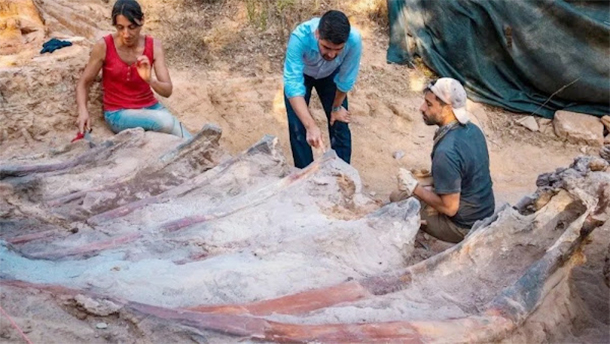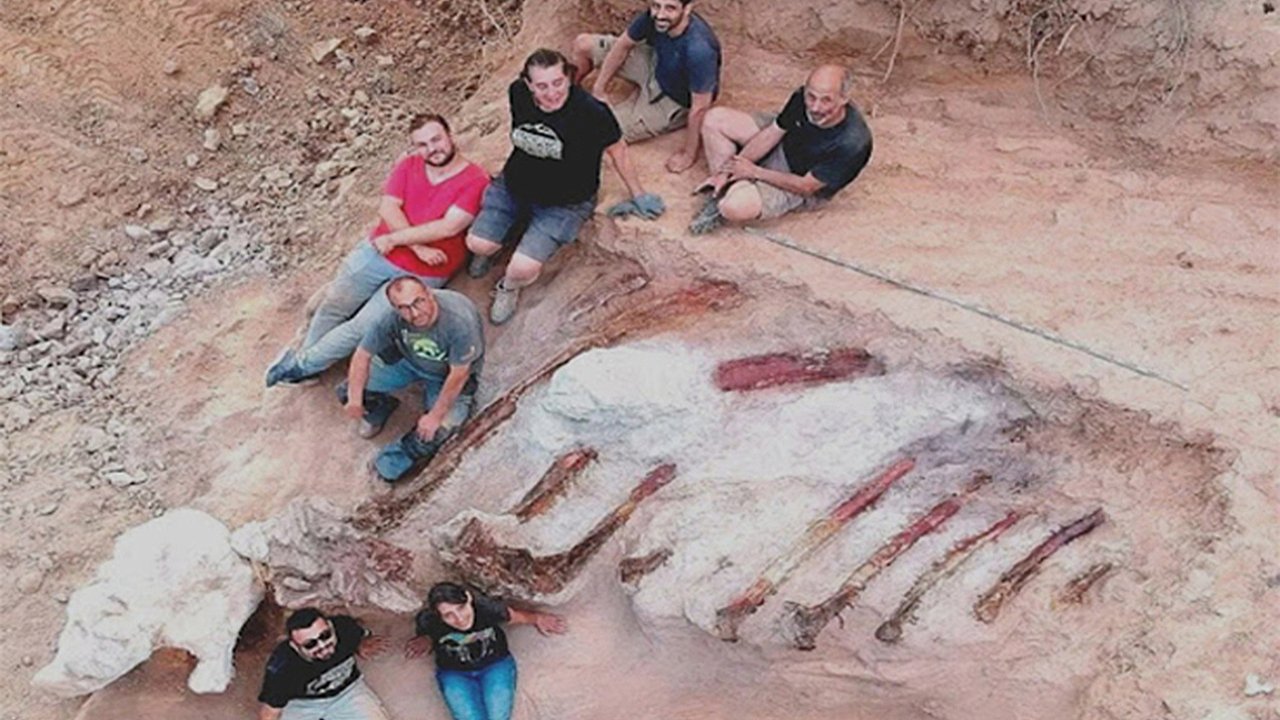Paleontologists from the University of Lisbon are leading an excavation of the site, where they have found well-preserved vertebrae and rib bones still in their original positions—a rare occurrence in dinosaur fossils. Given the exceptional preservation of the remains, researchers believe there may be more bones buried nearby. The excavation is a joint effort with scientists from institutions in Spain, providing valuable insights into the morphology and evolution of Jurassic sauropods. The research carried out at the Monte Agudo paleontological site underlines the importance of the fossil record of vertebrates in the Pombal region (Portugal). Image credit: Instituto Dom Luiz (Faculty of Sciences of the University of Lisbon)Imagine the surprise of discovering that your backyard once hosted one of the largest creatures to walk the Earth—quite literally!In a remarkable turn of events, a man from Pombal, Portugal, unearthed fossilized remains while doing construction work in his yard back in 2017. The bones appeared massive, and after notifying paleontologists from the University of Lisbon, a team began an excavation process to investigate this prehistoric find.After five years of study, researchers now conclude that the remains are from a gigantic brachiosaurid sauropod. This herbivorous, long-necked dinosaur roamed the earth during the Late Jurassic Period, roughly 160 to 100 million years ago.
The research carried out at the Monte Agudo paleontological site underlines the importance of the fossil record of vertebrates in the Pombal region (Portugal). Image credit: Instituto Dom Luiz (Faculty of Sciences of the University of Lisbon)Imagine the surprise of discovering that your backyard once hosted one of the largest creatures to walk the Earth—quite literally!In a remarkable turn of events, a man from Pombal, Portugal, unearthed fossilized remains while doing construction work in his yard back in 2017. The bones appeared massive, and after notifying paleontologists from the University of Lisbon, a team began an excavation process to investigate this prehistoric find.After five years of study, researchers now conclude that the remains are from a gigantic brachiosaurid sauropod. This herbivorous, long-necked dinosaur roamed the earth during the Late Jurassic Period, roughly 160 to 100 million years ago. Researchers excavate the fossilized ribs of a sauropod at the Monte Agudo paleontological site in Pombal, Portugal. Image credit: Instituto Dom Luiz (Faculty of Sciences of the University of Lisbon, Portugal)The sauropod group includes other famous giants, such as Brachiosaurus altithorax from North America, Giraffatitan brancai from Africa, and Lusotitan atalaiensis from Portugal’s western region. Now, this discovery in Pombal is recognized as the largest dinosaur ever found in Europe, measuring approximately 39 feet in height and over 82 feet in length.The excavation, part of ongoing research at Monte Agudo, highlights Portugal's paleontological significance. Elisabete Malafaia, a postdoctoral researcher from the University of Lisbon, explained that finding dinosaur ribs in their original position is rare, especially with sauropods from Portugal’s Upper Jurassic period. Because the preservation is so exceptional, researchers suspect more of the skeleton remains hidden at the site.Currently, critical elements like vertebrae and rib bones have been recovered, and the team plans additional digs to uncover even more of this prehistoric giant. Some bones are still being prepared in a lab to remove sediment layers, which will allow scientists to conduct further studies at a museum, improving the accuracy of identification and eventual public display.
Researchers excavate the fossilized ribs of a sauropod at the Monte Agudo paleontological site in Pombal, Portugal. Image credit: Instituto Dom Luiz (Faculty of Sciences of the University of Lisbon, Portugal)The sauropod group includes other famous giants, such as Brachiosaurus altithorax from North America, Giraffatitan brancai from Africa, and Lusotitan atalaiensis from Portugal’s western region. Now, this discovery in Pombal is recognized as the largest dinosaur ever found in Europe, measuring approximately 39 feet in height and over 82 feet in length.The excavation, part of ongoing research at Monte Agudo, highlights Portugal's paleontological significance. Elisabete Malafaia, a postdoctoral researcher from the University of Lisbon, explained that finding dinosaur ribs in their original position is rare, especially with sauropods from Portugal’s Upper Jurassic period. Because the preservation is so exceptional, researchers suspect more of the skeleton remains hidden at the site.Currently, critical elements like vertebrae and rib bones have been recovered, and the team plans additional digs to uncover even more of this prehistoric giant. Some bones are still being prepared in a lab to remove sediment layers, which will allow scientists to conduct further studies at a museum, improving the accuracy of identification and eventual public display. The sauropod’s ribs were preserved in their original anatomical position. Image credit: Instituto Dom Luiz (Faculty of Sciences of the University of Lisbon, Portugal)This groundbreaking work is a collaborative effort between the Instituto Dom Luiz at the University of Lisbon, the Evolutionary Biology Group at UNED-Madrid, and the Faculty of Fine Arts at Complutense University of Madrid. The findings will advance knowledge about the structure and evolution of sauropods and shed light on Portugal’s ancient ecosystems.
The sauropod’s ribs were preserved in their original anatomical position. Image credit: Instituto Dom Luiz (Faculty of Sciences of the University of Lisbon, Portugal)This groundbreaking work is a collaborative effort between the Instituto Dom Luiz at the University of Lisbon, the Evolutionary Biology Group at UNED-Madrid, and the Faculty of Fine Arts at Complutense University of Madrid. The findings will advance knowledge about the structure and evolution of sauropods and shed light on Portugal’s ancient ecosystems.
 The research carried out at the Monte Agudo paleontological site underlines the importance of the fossil record of vertebrates in the Pombal region (Portugal). Image credit: Instituto Dom Luiz (Faculty of Sciences of the University of Lisbon)Imagine the surprise of discovering that your backyard once hosted one of the largest creatures to walk the Earth—quite literally!In a remarkable turn of events, a man from Pombal, Portugal, unearthed fossilized remains while doing construction work in his yard back in 2017. The bones appeared massive, and after notifying paleontologists from the University of Lisbon, a team began an excavation process to investigate this prehistoric find.After five years of study, researchers now conclude that the remains are from a gigantic brachiosaurid sauropod. This herbivorous, long-necked dinosaur roamed the earth during the Late Jurassic Period, roughly 160 to 100 million years ago.
The research carried out at the Monte Agudo paleontological site underlines the importance of the fossil record of vertebrates in the Pombal region (Portugal). Image credit: Instituto Dom Luiz (Faculty of Sciences of the University of Lisbon)Imagine the surprise of discovering that your backyard once hosted one of the largest creatures to walk the Earth—quite literally!In a remarkable turn of events, a man from Pombal, Portugal, unearthed fossilized remains while doing construction work in his yard back in 2017. The bones appeared massive, and after notifying paleontologists from the University of Lisbon, a team began an excavation process to investigate this prehistoric find.After five years of study, researchers now conclude that the remains are from a gigantic brachiosaurid sauropod. This herbivorous, long-necked dinosaur roamed the earth during the Late Jurassic Period, roughly 160 to 100 million years ago. Researchers excavate the fossilized ribs of a sauropod at the Monte Agudo paleontological site in Pombal, Portugal. Image credit: Instituto Dom Luiz (Faculty of Sciences of the University of Lisbon, Portugal)The sauropod group includes other famous giants, such as Brachiosaurus altithorax from North America, Giraffatitan brancai from Africa, and Lusotitan atalaiensis from Portugal’s western region. Now, this discovery in Pombal is recognized as the largest dinosaur ever found in Europe, measuring approximately 39 feet in height and over 82 feet in length.The excavation, part of ongoing research at Monte Agudo, highlights Portugal's paleontological significance. Elisabete Malafaia, a postdoctoral researcher from the University of Lisbon, explained that finding dinosaur ribs in their original position is rare, especially with sauropods from Portugal’s Upper Jurassic period. Because the preservation is so exceptional, researchers suspect more of the skeleton remains hidden at the site.Currently, critical elements like vertebrae and rib bones have been recovered, and the team plans additional digs to uncover even more of this prehistoric giant. Some bones are still being prepared in a lab to remove sediment layers, which will allow scientists to conduct further studies at a museum, improving the accuracy of identification and eventual public display.
Researchers excavate the fossilized ribs of a sauropod at the Monte Agudo paleontological site in Pombal, Portugal. Image credit: Instituto Dom Luiz (Faculty of Sciences of the University of Lisbon, Portugal)The sauropod group includes other famous giants, such as Brachiosaurus altithorax from North America, Giraffatitan brancai from Africa, and Lusotitan atalaiensis from Portugal’s western region. Now, this discovery in Pombal is recognized as the largest dinosaur ever found in Europe, measuring approximately 39 feet in height and over 82 feet in length.The excavation, part of ongoing research at Monte Agudo, highlights Portugal's paleontological significance. Elisabete Malafaia, a postdoctoral researcher from the University of Lisbon, explained that finding dinosaur ribs in their original position is rare, especially with sauropods from Portugal’s Upper Jurassic period. Because the preservation is so exceptional, researchers suspect more of the skeleton remains hidden at the site.Currently, critical elements like vertebrae and rib bones have been recovered, and the team plans additional digs to uncover even more of this prehistoric giant. Some bones are still being prepared in a lab to remove sediment layers, which will allow scientists to conduct further studies at a museum, improving the accuracy of identification and eventual public display. The sauropod’s ribs were preserved in their original anatomical position. Image credit: Instituto Dom Luiz (Faculty of Sciences of the University of Lisbon, Portugal)This groundbreaking work is a collaborative effort between the Instituto Dom Luiz at the University of Lisbon, the Evolutionary Biology Group at UNED-Madrid, and the Faculty of Fine Arts at Complutense University of Madrid. The findings will advance knowledge about the structure and evolution of sauropods and shed light on Portugal’s ancient ecosystems.
The sauropod’s ribs were preserved in their original anatomical position. Image credit: Instituto Dom Luiz (Faculty of Sciences of the University of Lisbon, Portugal)This groundbreaking work is a collaborative effort between the Instituto Dom Luiz at the University of Lisbon, the Evolutionary Biology Group at UNED-Madrid, and the Faculty of Fine Arts at Complutense University of Madrid. The findings will advance knowledge about the structure and evolution of sauropods and shed light on Portugal’s ancient ecosystems. 








